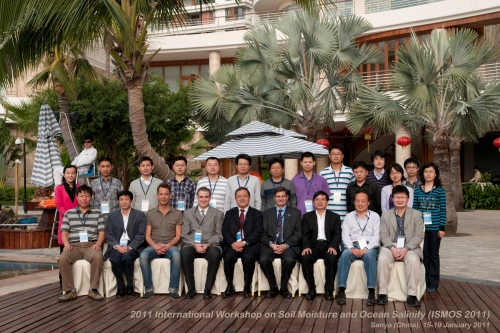2011 International Workshop on Soil Moisture and Ocean Salinity held in Hainan
2011 International Workshop on Soil Moisture and Ocean Salinity (ISMOS 2011) was held in Sanya, Hainan from January 15-19th, 2011. It is co-organized between the Center of Space Science and Applied Research (CSSAR), Chinese Academy of Sciences and the European Space Agency (ESA). Over 30 participants from China and Europe attended the conference. Prof. WU Ji, Director General of CSSAR, and Dr. Martin-Neira from ESA made the opening remarks.
ESA launched the Soil Moisture and Ocean Salinity satellite (SMOS) by Nov. 2009. After 6 months in orbit commissioning, the satellite has come into the operation phase since last June. Very good data products have been obtained, which include the first ever image of soil moisture and ocean salinity distribution in global scale. By SMOS mission, ESA lead the cutting edge L-band radiometry technology for 10 years. This workshop was divided into two parts. The first two days was dedicated to tutorials of the SMOS mission team and the last day was dedicated to presentations given by other participates. In the first part, three tutorials were given, i.e. scientific results by Yann Kerr (CESBIO, France), SMOS Lead Investigator; calibration and image reconstruction by Ignasi Corbella (UPC, Spain), a member of the SMOS Barcelona Expert Centre and was the general chairmen of IGARSS’07; MIRAS, the main payload onboard SMOS, by Manuel Martin-Neira (ESA-ESTEC), the Principal Engineer of SMOS payload. In the second part, 6 presentations over data explore, in situ calibration and validation, and future improvement were given. Most important is, the one dimensional Full Polarization Interferometric Radiometer (FPIR) which is proposed to future operational SMOS (SMOSops) were discussed in details on its scientific rationale, engineering feasibility and possibility of the improvements of FPIR demonstrator.
A conclusion was made after the workshop. Both ESA and CSSAR agreed to push the international collaboration on the observation of global soil moisture and ocean salinity. They all agree that the next step for cooperation should be on the level of hardware, such as to consider FPIR as a payload on the SMOSops satellites, which is proposed as the follow on mission of SMOS as the operational phase. For the Radio Frequency Interference (RFI) observed by SMOS over China, ESA expressed the appreciation to China that it may make a support to eliminate the RFI sources. This is in fact a benefit of both China and ESA since the RFI’s, the data of SMOS over China is in fact useless. If the RFI’s are stopped, both the soil moisture and ocean salinity data would be very useful for China. Finally, both sides agree that ISMOS workshop series should be more regular and frequent by locating it into the frame of Sino-ESA Dragon Programme.



